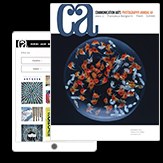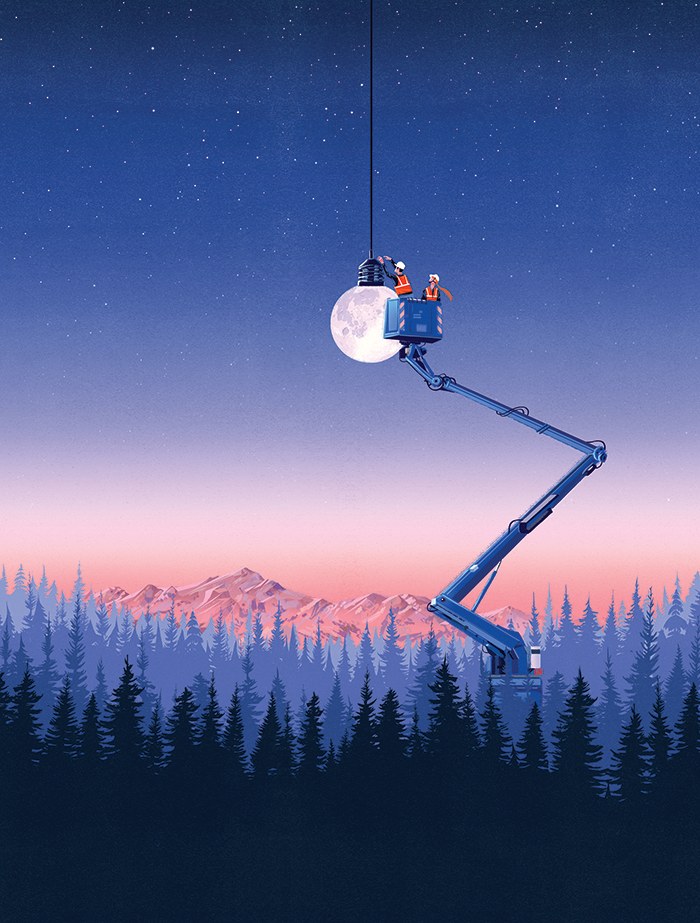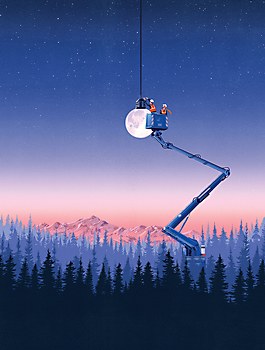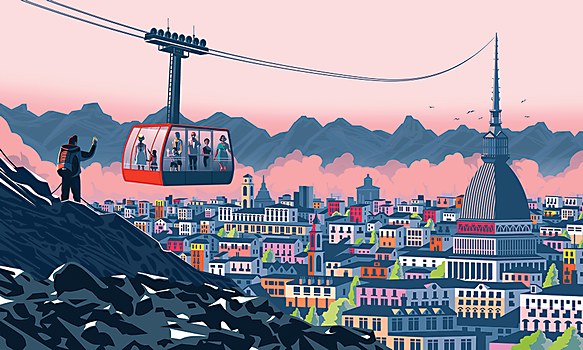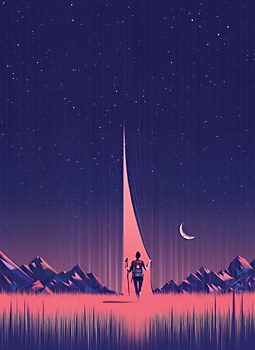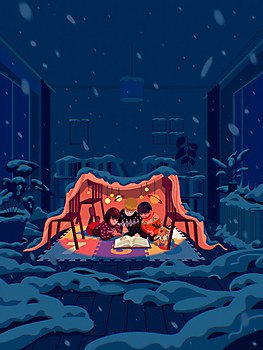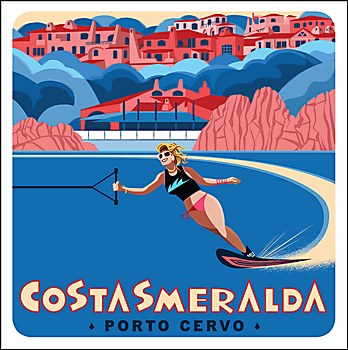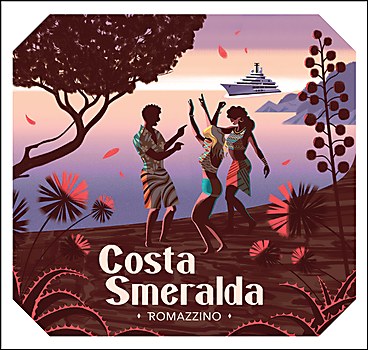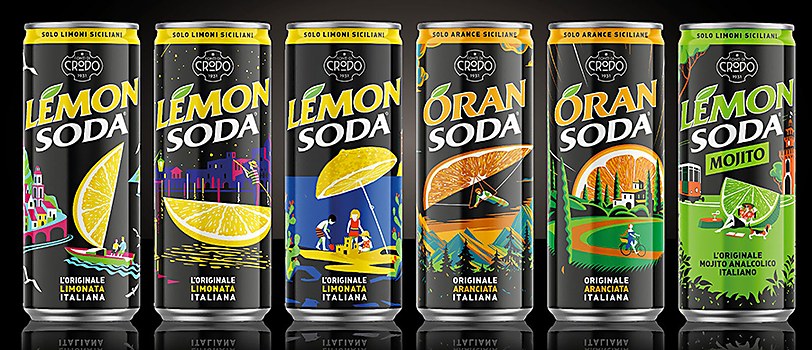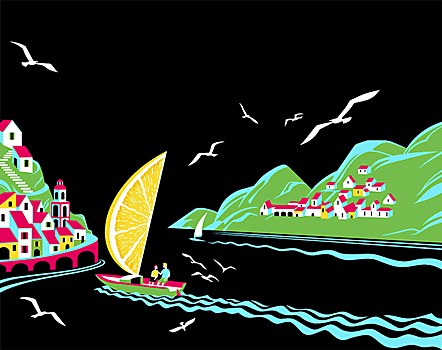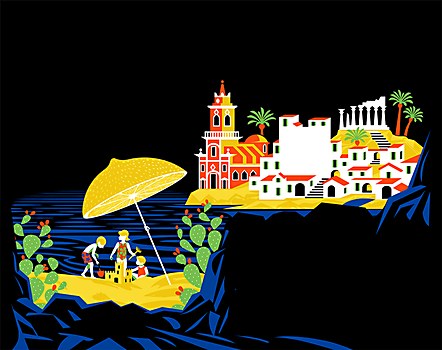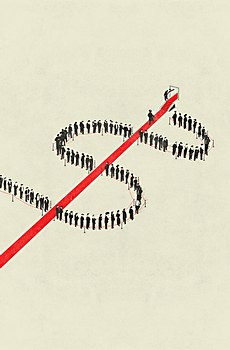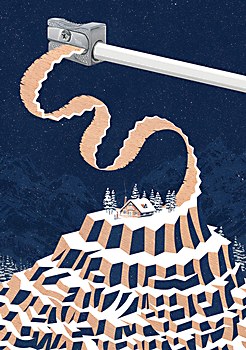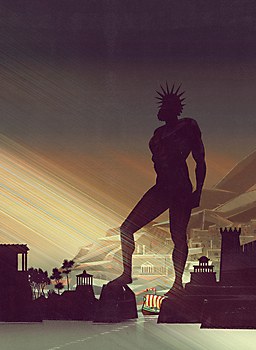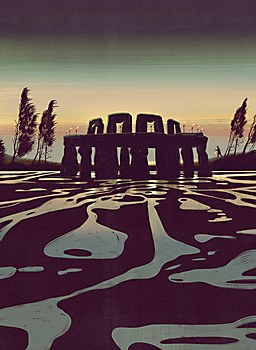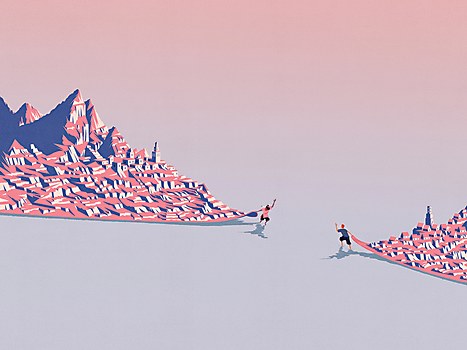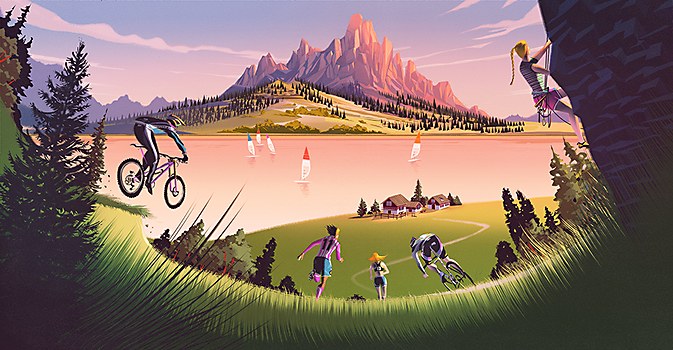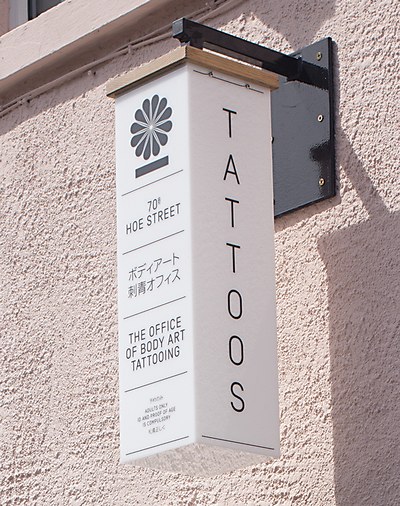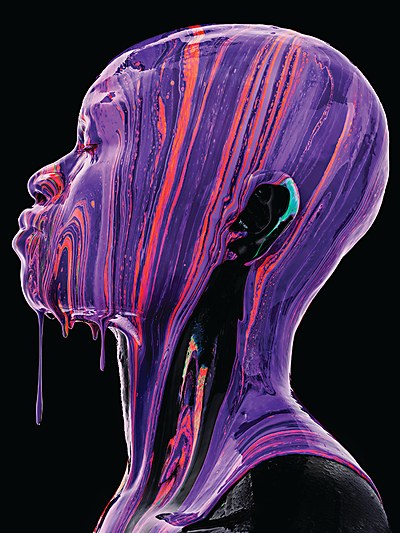Our interview with Francesco Bongiorni comes at just the right time for the Italian illustrator, who is now based in Madrid. It’s a period of change for him and his wife with the arrival of their first child. Little Leonardo came into the world in the last hours of 2022, and Bongiorni has taken a step back from most of his client work. There’s a baby in his home studio!
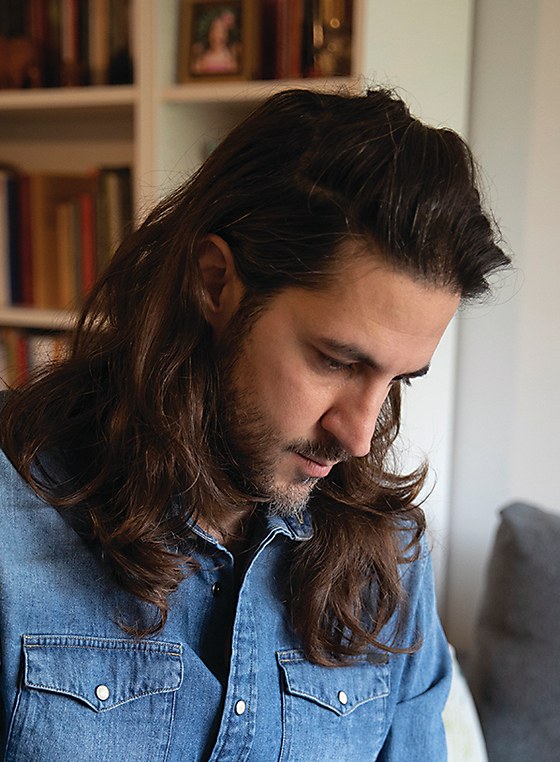
“It’s challenging, rewarding, fantastic,” he says, sweeping a strand of long brown hair from his brow. “It’s very interesting to see how he learns something every day, and every day there’s a little bit of growth.”
When Leonardo was born on New Year’s Eve, imagery created by his father was on billboards, trains, in videos, as a concert backdrop and on social media across Madrid. The Christmas in Madrid 2022 project, created for the city council and its cultural programming division Madrid Cultura, became a career highlight for Bongiorni for reasons both personal and professional.
Browse Projects
Bongiorni based the campaign’s main image on a Christmas experience he shared with his wife Maria Rosaria in 2020. Locked down by COVID, they were unable to return to Italy to see their families and were feeling low.
“So, we had dinner very early by Spanish standards, jumped in a car and went to see the city and its Christmas lights,” says Bongiorni. “Madrid was empty, and we went to the huge Puerta de Alcalá monument where we were completely alone. When I was asked to create the Christmas campaign, I remembered that scene.”
The brief was to include a few people in the image, including a couple with a child. With Maria pregnant at the time, Bongiorni imagined the characters in the poster to be his own family. “When Leonardo was born and the city was full of my illustrations, for me, it felt like hope for the future. That was very rewarding, and it was an honor to create something for Madrid, my adoptive home of fifteen years,” he says.
Perhaps Leonardo will grow up to become an illustrator too—after all, creativity seems to run in the family. Bongiorni’s brother and cousin are both artists, and his father was an architect in Milan. Going further back, his paternal grandfather kept a sketchbook diary of World War II and was a master wood sculptor in the 1950s, sending his humorous figurines all over the United States.
Having grown up surrounded by creativity, Bongiorni is very in touch with his family’s history and the personal stories they share. Conveying a story, a piece of history, an idea or an activity through an image is what drives his own creativity. “I don’t just draw: I draw to evoke something. For me, it’s important to have a story to tell, and the world is full of fascinating stories,” he explains.
When something catches Bongiorni’s imagination, he dives in and researches it. The topics he chooses are eclectic: hidden gems waiting to be unearthed and polished in his art. While we’re doing the interview, an exhibition of Bongiorni’s work is taking place in his home city of Milan that perfectly exemplifies his mindset.
For example, he published Atlante dei luoghi misteriosi d’Italia (“The Atlas of Mysterious Places in Italy”) in 2018, followed by Atlante dei luoghi misteriosi del’antichità (“The Atlas of Mysterious Places of Antiquity”) in 2020, which won a gold medal at the Society of Illustrators in 2021. Both feature dozens of mysteries and legends throughout history, depicting everything from Vlad the Impaler’s crypt in Naples to the ghost town of Consonno in Lombardy in the former and from the Lascaux Caves in France to the Hanging Gardens of Babylon in the latter. For these, Bongiorni carried out in-depth research before capturing his discoveries in full-page, full-color illustrated plates. Now, images from both books have been put on display at that exhibition of his work in Milan.
Bongiorni initiated both atlases himself. “For fifteen years, I’d worked in a very conceptual style that suited editorial clients,” he explains. “I started to feel uncomfortable doing what everybody else was doing. I remembered a story my father told me about [architect] Le Corbusier, who invented a philosophy based on five rules. Everybody started doing the same, so he became annoyed with his own style and decided to do something different. With the Chapel de Ronchamp, he broke all his own rules and invented something really cool. I wanted to do something similar.
“So, I invented the atlas project because I am passionate about strange stories, dark legends and mysterious places,” he continues. “I pitched the idea to the publisher [and] found a writer I liked, and we started work. I only had two conditions: first, I wanted to be my own art director, and second, I wanted to personally choose some of the places because I wanted to do my own research, not rely only on the writer.”
From his graphic, concept-driven style known by clients such as the Guardian, The Washington Post and the Wall Street Journal, Bongiorni has widened the angle to take in architecture, monuments and landscapes as well as the stories that make them interesting. He still crafts his images in Photoshop, dipping into his vast library of handmade brushstrokes and natural media textures, but this is illustration with feeling.
Commissions truly resonate when there’s a personal connection, which is why Bongiorni regards his 2022 work for Lemonsoda as a milestone project. “Lemonsoda was an almost mythical brand when I was a child,” he says. “In Italy, it was like Coca-Cola, but it almost disappeared. Now, it’s coming back, and working on this project gave me a special feeling.”
Briefed by the Milan creative agency Smith Lumen, Bongiorni created wraparound artwork for a limited edition of six cans, illustrating Italian landscapes both urban and rural. There were certain parameters to adhere to, with a grid delineating where the branding, ingredients, barcode and QR code would go. The palette for each can could only use six colors, including green, yellow, black and white.
And there were further limitations due to the Italian Code of Cultural Heritage and Landscape. Under this code, the commercial use of cultural property such as artworks and historic monuments requires authorization, which often comes at a cost. To solve this problem, Bongiorni imaginatively represented the Amalfi Coast, the Dolomites, Milan, Sicily and Venice, without re-creating any specific landmarks.
“For example, in Milan, we have Castello Sforzesco,” he says. “Because I’m from the city, I know that the Sforza family built a series of castles which are all similar, so I collected reference pics and drew a tower from one of them, a wall from another and took the door from another. It was fun for me because I love researching interesting places.”
The creative team at Smith Lumen were drawn to Bongiorni because of his strong, impactful style. Senior designer Cinzia Crotti explains: “The concept was complex: a surreal journey through Italy with dreamlike landscapes where the key ingredients of Lemonsoda interact with realistic elements of our country. When we saw Francesco’s portfolio, we knew he was perfect for our project. He is a conceptual, sensitive artist capable of telling a story through his drawings while synthesizing complex ideas in an original way.”
Year on year, Lemonsoda sales increased by more than 30 percent with Bongiorni’s artwork on the packaging. “Another way of evaluating the success of the collection is to be found in the achievement of Lemonsoda’s strategic brand objectives,” says Giorgia Corte, strategist at Smith Lumen, “namely those of consolidating its positioning as an iconic Italian brand, capitalizing on the brand’s association with the concept of Italian summer and communicating the quality of the citrus fruits used in the recipe: a perfect blend of taste and style, which has thrilled consumers.”
Full of angular forms with flat shades to create three-dimensional buildings, fruit and landforms, the Lemonsoda illustrations are an excellent demonstration of Bongiorni’s style. The imagery is simple and impactful yet has enough detail to engage viewers, with Easter eggs to discover in each illustration as they sip the drink.
The project harks back to a superb pro bono piece Bongiorni created for Doctors Without Borders in 2018. Entitled One Million Steps, the poster depicts two men approaching one another across shallow water, each pulling an immense, blanket-like landmass behind him. On average, a migrant walks a million steps from Africa or the Middle East to reach Europe. While many see migrants in a negative light, Bongiorni wanted to show cultures and civilizations coming together and sharing their humanity.
The piece also bridges Bongiorni’s early, more graphic-led work with the visual storytelling and detailed landscapes he prefers today. There’s a fascinating color palette at work—a pinkish orange juxtaposed with a muted blue. “I don’t have problems with drawing or shading, but color is my Achilles heel,” says Bongiorni. “I keep changing the colors in an illustration until the last second.”
Utilizing painter Johannes Itten’s color theory, Bongiorni selects opposites as signature tones, such as the blue and orange in One Million Steps, and contrasts them with a muddy blend of the two. Hence, the pale, bland sea is almost ugly in comparison to the two landforms, which help guide the eye into the composition toward the space between the characters.
The winner of a silver medal in the Society of Illustrators’s annual awards, the illustration was made in homage to MC Escher’s Metamorphosis series, which also depicts and distorts scenes from the Amalfi Coast. The rock faces and architecture overlap and blend into one another, creating a fragmented geometry echoing Escher’s drawings of terraced farms, villages and cliffs of southern Italy in the 1930s.
In addition to Escher, Bongiorni cites the British artist Norman Wilkinson and the Italian engraver Federica Galli as influences. The dramatic, layered landscapes of Wilkinson’s tourist posters and the fine detail of Galli’s Milano engravings are both evident in many of his works.
As well as looking after his son, taking a break from commercial work has allowed Bongiorni to catch up on some of his interests and personal projects. He enjoys buying anonymous artwork via online auctions and researching unknown artists. He’s also cultivating his own chili peppers in a hydroponic setup next to his desk. Plans are afoot to crosspollinate Brazilian and Peruvian peppers for a unique new flavor.
Bongiorni has just finished screen printing Tiny Islands, a project that has long been in the works and indulges his fascination with tiny islands from all over the world. “I have a lot of strange and curious interests—absurd passions—I’m afraid,” he explains. “I started to work on it when we were under lockdown in Madrid, so I guess it represents how a small space can become your kingdom, with its own unique characteristics and laws.”
With the Tiny Islands prints going on sale in his online shop, one thing Bongiorni wants to do when commissions resume is to create more wine and beer labels. “What motivates me most is being able to capture a reality or an activity closely linked with a place or a territory,” he says. “Telling the story of a winery or brewery that creates a unique product in symbiosis with its surroundings would be perfect for me. It’s what I love to do.” ca








